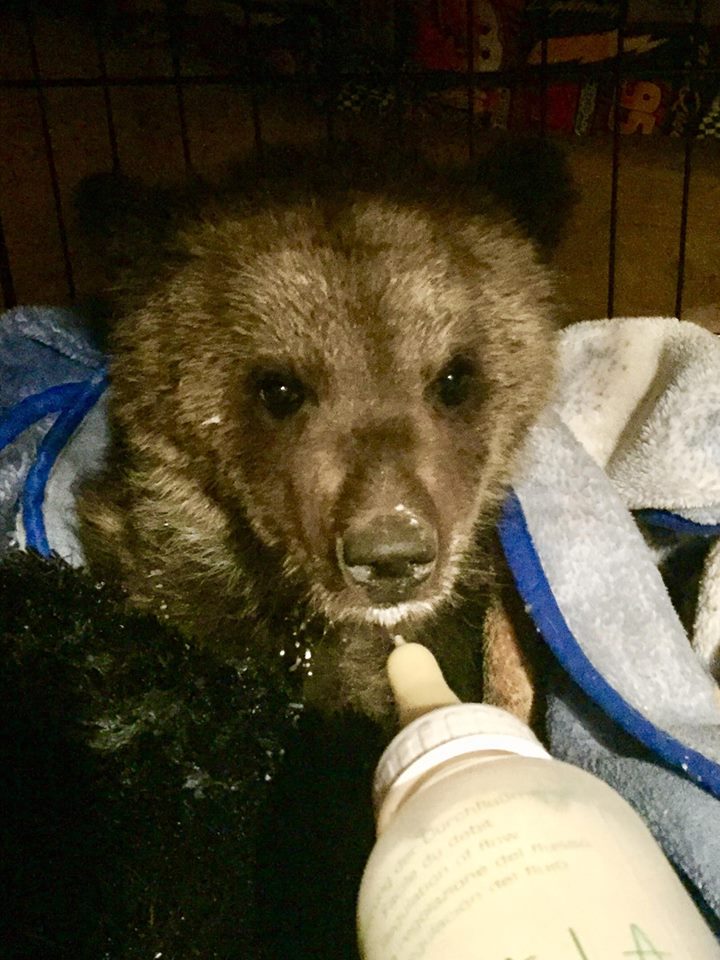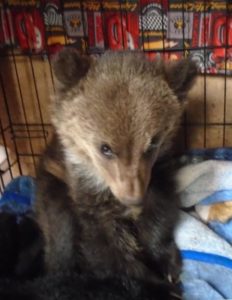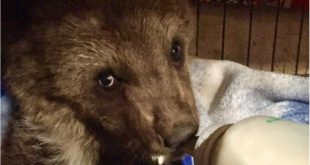On May 3, 2018 witnesses observed a grizzly cub under a bridge near Grand Cache, Alberta. They called the Grand Cache Animal Society. Brandy Gienger, one of the founders of the Society, went to the site to check on the condition of the cub. She advised the provincial Fish and Wildlife department of the cub’s location, and was told to leave him as the mother more than likely stashed the cub to go hunting and would probably return. After three days the cub was still there, but on the fourth day he was nowhere to be seen. She assumed that Fish and Wildlife had picked him up, or the mother had returned. On the fifth day she received a call that the cub was back under the bridge.
The cub was weak but feisty, and was fairly easy to catch. She took him to her property, and under the guidance of a grizzly rehabilitation expert began to nurse him back to health, careful to avoid habituating him to human contact by keeping him in a dark area and feeding him goat milk. She was advised to give him a fuzzy stuffed animal to keep him company. He was under her care for almost three days.

VAN: You found a certified rehabilitation centre with grizzly experience that agreed to take Groot as long as inter-provincial conditions were met. But after an anonymous woman called Fish and Wildlife with a suspicion that you had the cub, you received a phone call from Conservation Officer Cody Knack. What did he say to you at that time?
BG: Cody stated that he received a call saying I had the cub and he threatened a search warrant and jail time if I did not hand the cub over to him. I stated I knew were the cub was being held and said that we found a rescue
to take him in.
VAN: You were ready and willing to get Groot to the rescue centre on Thursday, May 10, but you received a call from the Fish and Wildlife Officer Service that they were on their way to pick up the cub. You were to meet them at 1pm.
BG: Conservation Officer Cody Knack and the Inspector for Grande Prairie Unit, Dwayne Matier met me at the Conservation Office in town. In our small town we noticed the presence of a few more Conservation vehicles, more than normal. I think they were expecting trouble from me.
VAN: How did they handle Groot when you gave him to them?
BG: They took the box I had him in and put him in the back seat of their truck.
VAN: Dwayne Matier and Cody Knack assured you that Fish and Wildlife would take the best interests of the bear into consideration and give him he best chance possible.
BG: I told him that there was no laws that could protect Groot from the Fish and Wildlife department. By then I had done enough research and talked to enough specialists to know that the cub was not safe with them.
VAN: The next day you received a phone call from Paul Frame, the Provincial Carnivore Specialist from Wildlife Management Policy. He asked you if you would consider removing the post on social media as they did not want public outcry. He told you that the public had already sent over 1000 emails and calls and they were overwhelmed. The emails and calls were taking precious time away from addressing the policy. He then told you that Groot had been killed, claiming that the cub had no chance of survival, and that a specialist had been consulted over the phone.
BG: He was more upset that Fish and Wildlife didn’t get Groot out of the public’s eye sooner. He stated that they “dropped the ball” on getting him out of view.
How is a specialist supposed to know this without even seeing the bear? Without even taking it under veterinarian care or looking at him? There’s no way to tell that that bear did not have a chance over the phone. I have veterinary experience and I believe beyond a doubt that cub was strong enough to be rehabilitated if given the chance. His bodily functions were working well, proving that his kidney and liver were functioning.
The following is the media statement by the Ministry regarding the killing of the cub.
“While Alberta Environment and Parks tried to determine if there was a facility that would accept a grizzly bear under permanent care, such as a zoo, unfortunately, no permanent placement for the bear was
immediately available. The bear was emaciated, dehydrated, lethargic and near death, and specialists did not believe it would survive. To limit the bear’s suffering, the bear was euthanized in accordance with the Canadian Council of Animal Care guidelines. This was a very sad situation, but unfortunately, officials felt the most humane thing to do was to limit the animal’s suffering. The decision to humanely euthanize this grizzly bear cub was not made lightly.”
In a Calgary Herald article from November 7, 2017 regarding an injured black bear cub in a field west of Calgary, provincial officials said they feared that helping the cub would set an expensive precedent for helping other wildlife.
The provincial officials and most of the public know very well that wildlife rehabilitation centres are funded almost entirely by public donations. The roles of the British Columbian and Albertan governments are to create policies, regulate them and issue permits to private rehabilitation centres. At this writing we are not sure what that “expensive precedent” is that Calgary officials are referring to.



Recent Comments